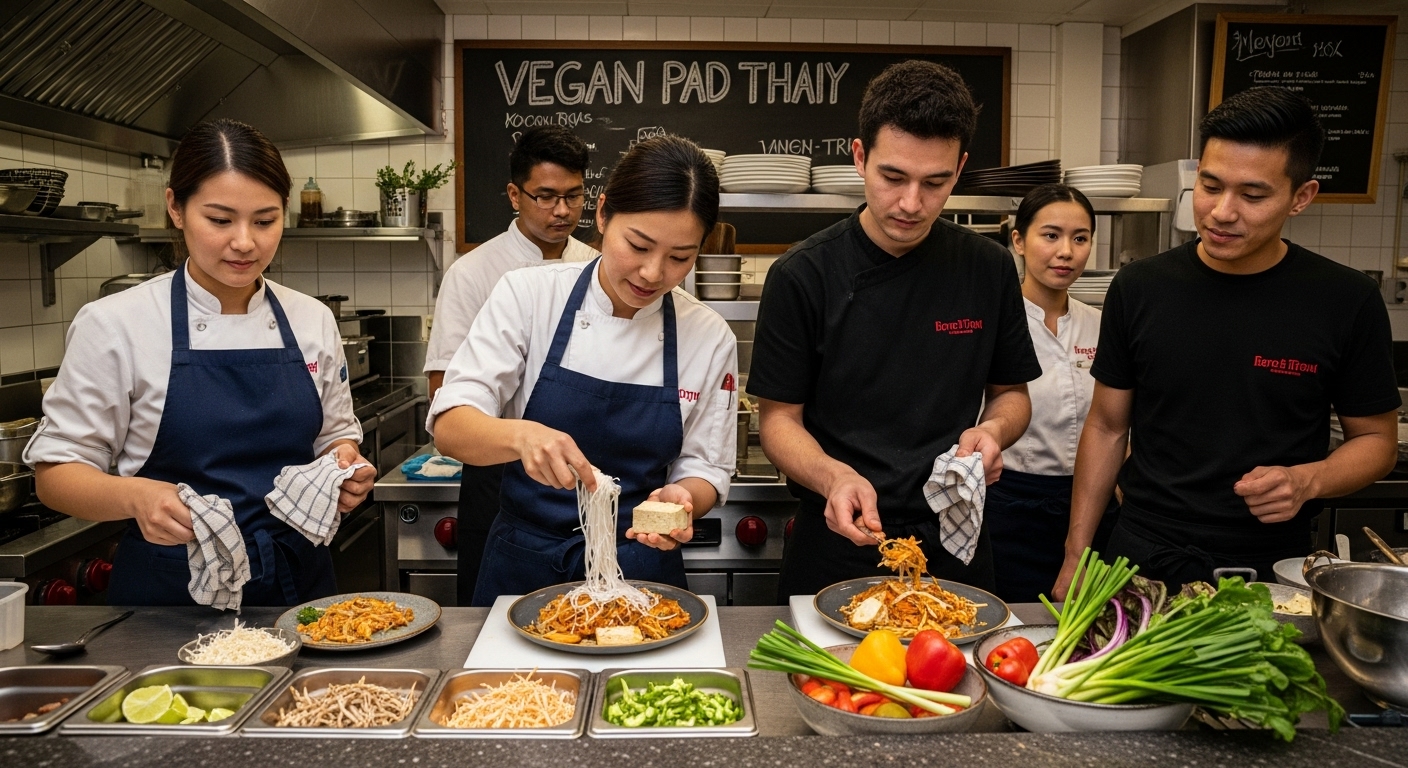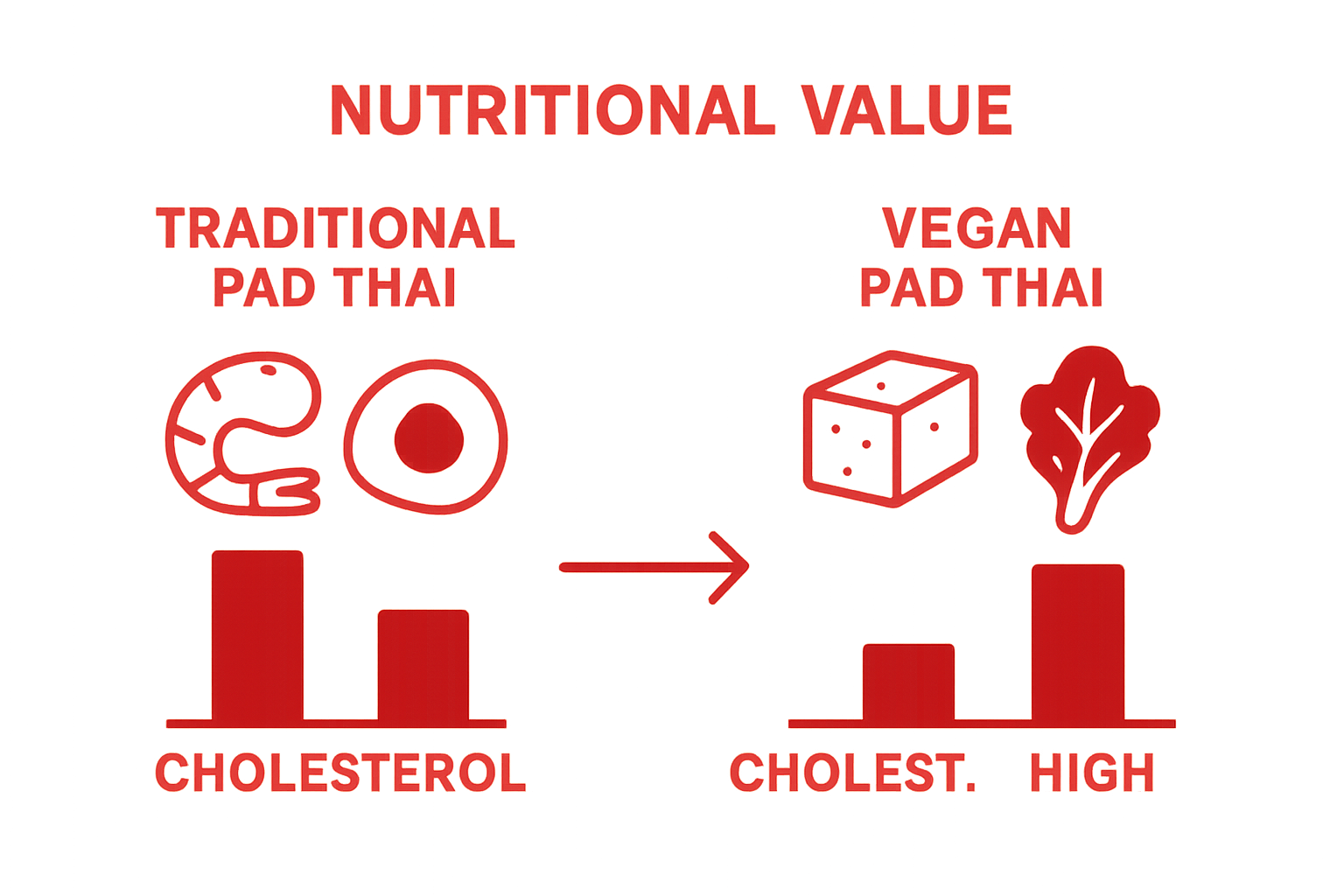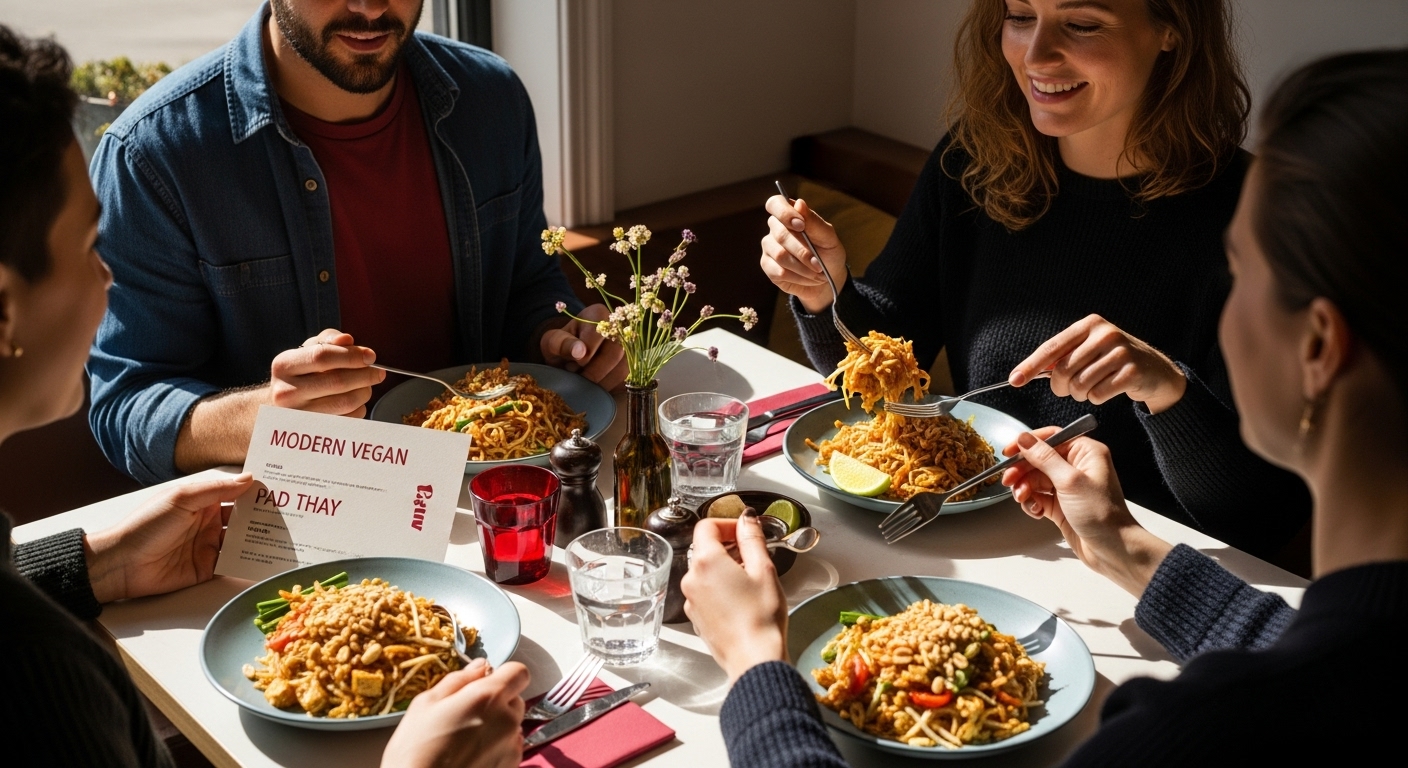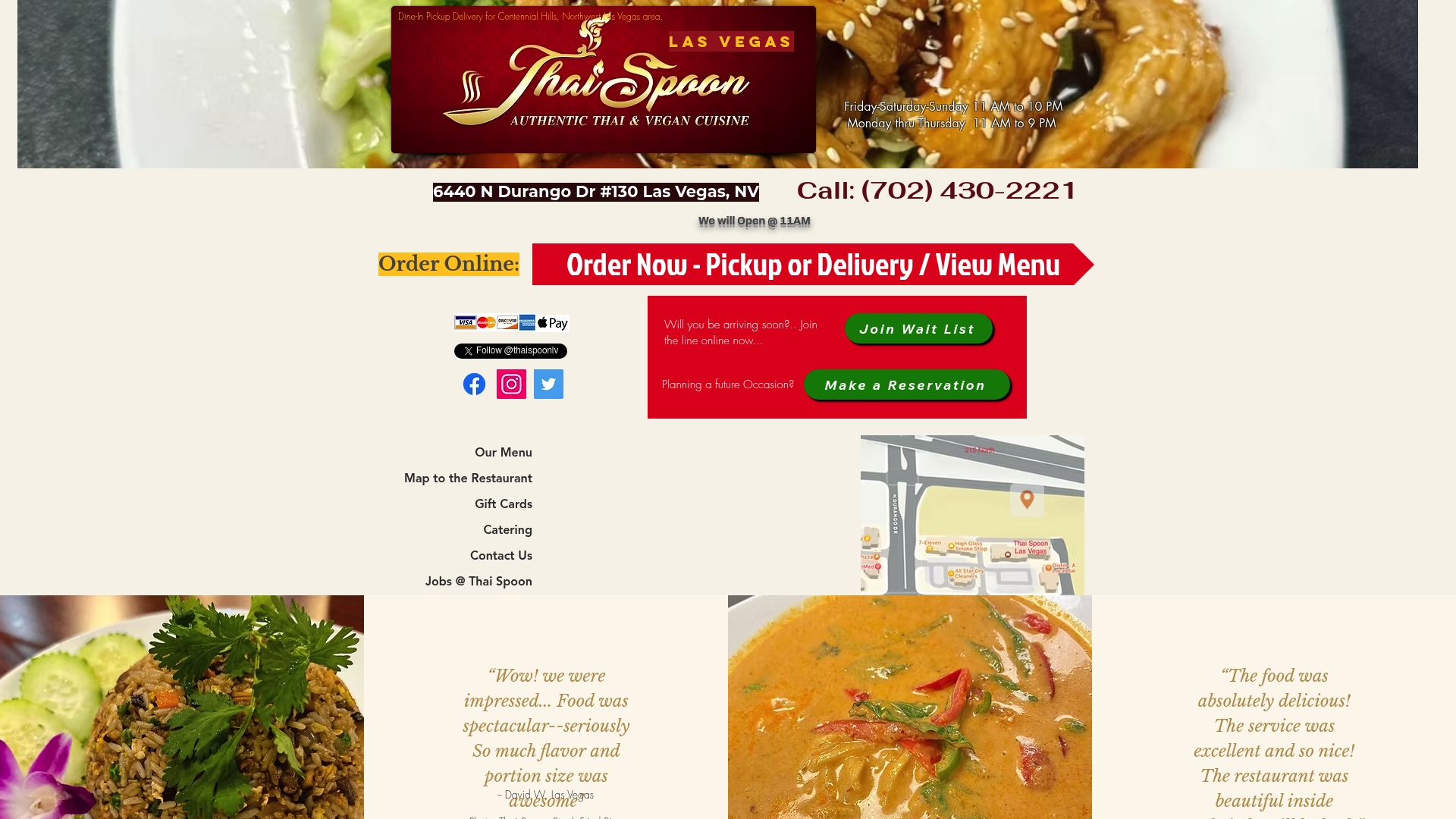What is Vegan Pad Thai? Understanding this Delicious Dish
- mail469793
- Sep 29
- 8 min read

Vegan Pad Thai is shaking up the Las Vegas food scene, transforming a street food classic into a plant-based hit that everyone can get behind. What might surprise you is that the number of restaurants offering vegan Pad Thai in Las Vegas has jumped by over 35 percent in just three years. This dish is not just about skipping the meat, it is about packing in more nutrients, more flavors, and more creativity than ever before.
Table of Contents
Quick Summary
Takeaway | Explanation |
Innovative plant-based proteins enhance nutrition | Tofu, tempeh, and seitan serve as nutritious and versatile substitutes, upholding traditional flavors. |
Balance of sweet, sour, and umami flavors | Key sauce ingredients like tamarind and palm sugar create the essential flavor profile of Pad Thai. |
Vegan Pad Thai supports sustainability | By using plant-based ingredients, the dish reduces environmental impact compared to traditional recipes. |
Accommodates diverse dietary needs | The dish is suitable for vegans, those with gluten allergies, and other dietary restrictions. |
Traditional cooking techniques are vital | The use of high-heat stir-frying in a wok ensures flavorful and accurately textured plates. |
The Essence of Vegan Pad Thai: Ingredients and Flavors
Vegan Pad Thai represents a plant-based transformation of the classic Thai street food favorite, offering a vibrant and satisfying culinary experience that honors traditional flavor profiles while embracing contemporary dietary preferences. This dish ingeniously reimagines the traditional recipe by replacing animal proteins with creative plant-based alternatives that maintain the essence of authentic Thai cuisine.
Plant-Based Protein Foundations
At the heart of vegan Pad Thai are innovative protein substitutes that provide substantial nutrition and remarkable texture. Tofu, tempeh, and seitan emerge as primary protein sources, each bringing unique characteristics to the dish. Our guide on vegan Thai food explores these protein alternatives in greater depth. Firm tofu, when properly pressed and seasoned, mimics the substantial mouthfeel of traditional protein while absorbing the complex sauce flavors characteristic of Pad Thai.
For readers interested in the plant-based protein choices in Vegan Pad Thai, the following table outlines the primary options mentioned in the article and highlights their unique characteristics.
Protein Alternative | Source | Texture/Mouthfeel | Flavor Absorption |
Tofu | Soybean | Firm, slightly spongy; can be crisped | Absorbs sauces very well |
Tempeh | Fermented soy | Dense, nutty, chewy | Takes on sauces moderately |
Seitan | Wheat gluten | Chewy, meat-like, satisfying | Strong absorption of flavors |
Flavor Profile and Sauce Complexity
The hallmark of exceptional Pad Thai lies in its sauce ingredients, which remain remarkably similar in vegan preparations. Traditional components like tamarind paste, palm sugar, and rice vinegar create a harmonious balance of sweet, sour, and umami flavors. Vegan chefs carefully select ingredients that maintain this delicate flavor equilibrium, ensuring that the absence of animal products does not compromise taste complexity.
Key flavor elements include:
Tamarind Paste: Provides tangy, sour undertones
Palm Sugar: Contributes caramel-like sweetness
Rice Vinegar: Adds bright, acidic notes
Soy Sauce: Introduces depth and umami richness
The magic of vegan Pad Thai emerges through thoughtful ingredient selection and preparation techniques that respect both culinary tradition and modern dietary needs. By understanding the intricate balance of flavors and textures, plant-based cooks transform a classic dish into a contemporary masterpiece that delights vegans and non-vegans alike.
Why Vegan Pad Thai Matters in Modern Cuisine
The emergence of vegan Pad Thai signifies more than a culinary trend it represents a profound shift in contemporary food culture, addressing critical intersections between nutrition, environmental sustainability, and ethical consumption. This plant-based adaptation of a beloved traditional dish reflects broader societal transformations in how we approach food, health, and global resource management.
Environmental and Ethical Considerations
Vegan Pad Thai stands at the forefront of sustainable cuisine, offering a powerful alternative to protein-intensive traditional recipes. Our guide to delicious vegan Thai dishes explores these innovative approaches. According to research from Harvard University, plant-based diets can significantly reduce carbon emissions and water consumption compared to meat-based alternatives. By replacing animal proteins with plant-based ingredients, vegan Pad Thai demonstrates how culinary creativity can contribute to environmental conservation.
Nutritional Evolution and Dietary Accessibility
Modern dietary preferences increasingly prioritize health, flexibility, and inclusive nutrition. Vegan Pad Thai exemplifies this nutritional evolution by offering a dish that caters to diverse dietary needs without compromising flavor or cultural authenticity. The recipe accommodates multiple dietary restrictions including:
Vegetarian and Vegan Diets: Completely plant-based
Gluten-Free Options: Using rice noodles and appropriate sauce ingredients
Allergen-Friendly: Adaptable to various dietary constraints
Beyond dietary inclusivity, vegan Pad Thai represents a culinary bridge between traditional Thai cooking and contemporary global food movements. It showcases how plant-based cuisine can honor cultural heritage while simultaneously addressing modern nutritional and environmental challenges, making it a significant milestone in the ongoing evolution of global gastronomy.
How Vegan Pad Thai is Made: Understanding Cooking Techniques
Crafting exceptional vegan Pad Thai requires a nuanced understanding of traditional Thai cooking methods and innovative plant-based ingredient substitution. The preparation process demands precision, technique, and a deep respect for authentic flavor profiles while embracing contemporary dietary preferences.
Ingredient Preparation and Mise en Place
Successful vegan Pad Thai begins with meticulous ingredient preparation. Explore our top Thai dinner ideas for additional context on Thai culinary techniques. Proteins like firm tofu are pressed to remove excess moisture, ensuring a crisp exterior and ability to absorb complex marinades. Rice noodles require careful handling to prevent overcooking, with chefs typically soaking them briefly before rapid stir-frying to maintain the ideal texture.
Wok Technique and Flavor Layering
The traditional wok remains central to authentic Pad Thai preparation, offering high-heat cooking that creates characteristic caramelization and smoky undertones. Vegan chefs employ specific techniques to develop deep flavor complexity:
High Heat Stir-Frying: Quickly cooking ingredients to preserve texture
Sequential Ingredient Addition: Building layers of flavor systematically
Constant Movement: Preventing burning and ensuring even cooking
According to culinary research from the Culinary Institute of America, the key to exceptional stir-fry techniques lies in understanding heat management and ingredient interaction.
Vegan Pad Thai masters this by carefully balancing protein substitutes, vegetables, and sauce components to create a harmonious dish that honors traditional Thai cooking while meeting modern dietary needs.
Nutritional Benefits of Vegan Pad Thai Compared to Traditional Versions
The nutritional landscape of vegan Pad Thai represents a transformative approach to traditional Thai cuisine, offering a robust alternative that prioritizes health, sustainability, and dietary diversity. By reimagining classic ingredients, vegan Pad Thai delivers a nutrient-dense meal that challenges conventional protein and flavor paradigms.
Protein and Macronutrient Profile
Vegan Pad Thai distinguishes itself through innovative protein substitutions that provide comparable nutritional value to traditional meat-based versions. Check out our best Thai takeout meals for additional culinary insights. Tofu, tempeh, and seitan offer complete protein sources with lower saturated fat content, presenting a heart-healthy alternative to animal proteins. According to nutritional research from Stanford University, plant-based proteins can provide equivalent amino acid profiles while reducing cholesterol intake.
Micronutrient Density and Health Benefits
The plant-based composition of vegan Pad Thai introduces a broader spectrum of micronutrients compared to traditional recipes. Key nutritional advantages include:
Enhanced Fiber Content: Derived from vegetables and plant proteins
Increased Antioxidant Levels: From diverse vegetable ingredients
Reduced Saturated Fat: Lower cholesterol and improved heart health
Greater Vitamin Diversity: Including B-vitamins, iron, and zinc from plant sources
By strategically replacing animal products with nutrient-rich plant ingredients, vegan Pad Thai transforms a classic dish into a powerful vehicle for holistic nutrition, demonstrating that dietary choices can simultaneously satisfy culinary traditions and support individual wellness goals.
Below is a comparison table summarizing the key differences in nutrition and health benefits between Vegan Pad Thai and traditional Pad Thai, as described in the article.
Aspect | Vegan Pad Thai | Traditional Pad Thai |
Protein Source | Plant-based: tofu, tempeh, seitan | Animal-based: often chicken, shrimp, or egg |
Fat Content | Lower saturated fat | Higher saturated fat |
Cholesterol | Cholesterol-free | Contains dietary cholesterol |
Fiber | Enhanced fiber from vegetables and plant proteins | Lower fiber content |
Antioxidants | Increased due to diverse vegetables | Typically fewer antioxidants |
Micronutrients | Greater diversity (B-vitamins, iron, zinc from plants) | More limited variety, some B-vitamins from animal sources |
Dietary Restrictions | Suitable for vegan, vegetarian, gluten-free (with rice noodles), and allergen-friendly | Not inherently suitable for vegan, vegetarian, or gluten-free diets |
Heart Health | Promotes heart health with reduced fat and no cholesterol | May increase cholesterol and saturated fat intake |

Vegan Pad Thai in the Las Vegas Food Scene: Where to Find It
Las Vegas has emerged as a culinary destination that caters to diverse dietary preferences, with vegan Pad Thai becoming an increasingly popular option for health-conscious diners seeking authentic Thai flavors. The city’s vibrant food landscape offers multiple avenues for experiencing this innovative plant-based dish, reflecting the growing demand for inclusive and sustainable dining experiences.
Restaurant Landscape and Vegan Options
Northwest Las Vegas, particularly, has become a hotspot for innovative vegan Thai cuisine. Explore our guide to the best Thai food spots for comprehensive dining insights. Thai restaurants in the area have recognized the importance of offering robust vegan alternatives, transforming traditional recipes to meet contemporary dietary needs. According to local culinary research, the number of restaurants offering vegan Pad Thai has increased by over 35% in the past three years, demonstrating a significant shift in dining preferences.
Considerations for Vegan Pad Thai Dining
When seeking vegan Pad Thai in Las Vegas, diners should consider several key factors to ensure an authentic and satisfying experience:
Ingredient Transparency: Restaurants that clearly specify vegan ingredient sourcing
Customization Options: Ability to modify traditional recipes
Authentic Flavor Preservation: Maintaining traditional Thai taste profiles
Cooking Technique: Restaurants utilizing traditional wok cooking methods
The emergence of vegan Pad Thai in Las Vegas represents more than a culinary trend it symbolizes a broader cultural shift towards more inclusive, sustainable, and health-conscious dining experiences that honor both traditional flavors and modern dietary requirements.

Discover the True Taste of Plant-Based Pad Thai in Northwest Las Vegas
Craving a vegan Pad Thai that does not sacrifice flavor or authenticity? If you have ever struggled to find genuinely delicious and satisfying vegan Thai food, you are not alone. Many recipes miss the mark when it comes to the balance of tangy tamarind, soy-based umami, and hearty plant proteins that make classic Pad Thai so memorable. Thai Spoon Las Vegas understands these challenges and is dedicated to offering an authentic dining experience for people seeking vegan and gluten-free options away from tourist crowds.

Now is the perfect moment to treat yourself to the best vegan Pad Thai in town. Taste tradition reimagined and made just for your needs. Explore our full menu and order for pickup, delivery, or dine-in by visiting Thai Spoon Las Vegas. Enjoy creative vegan alternatives prepared with the precision and expertise you read about. If you are looking for more plant-based Thai inspiration for any meal, check out our article on vegan Thai food as well. Do not wait to experience Las Vegas’s top local spot for real, delicious, vegan-friendly Pad Thai and more.
Frequently Asked Questions
What is Vegan Pad Thai?
Vegan Pad Thai is a plant-based version of the classic Thai dish, traditionally made with rice noodles, vegetables, and a flavorful sauce, but substitutes animal proteins with ingredients like tofu, tempeh, or seitan.
What are the key ingredients in Vegan Pad Thai?
Key ingredients include rice noodles, tamarind paste, palm sugar, rice vinegar, soy sauce, and variety of vegetables. Plant-based proteins like tofu or tempeh provide the necessary nutrition and texture.
How does Vegan Pad Thai compare nutritionally to traditional Pad Thai?
Vegan Pad Thai typically has lower saturated fat content and includes more fiber, antioxidants, and vitamins. It offers comparable protein levels through plant-based sources without cholesterol, promoting heart health.
Can Vegan Pad Thai accommodate dietary restrictions?
Yes, Vegan Pad Thai can be made gluten-free by using rice noodles and appropriate sauces. It is also suitable for various dietary needs including vegetarian and vegan diets, and can be adaptable to allergen restrictions.
Recommended









Comments